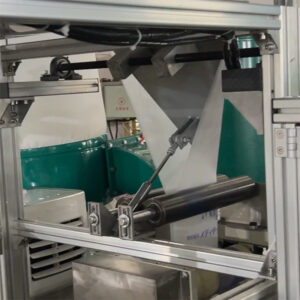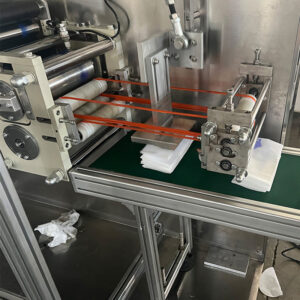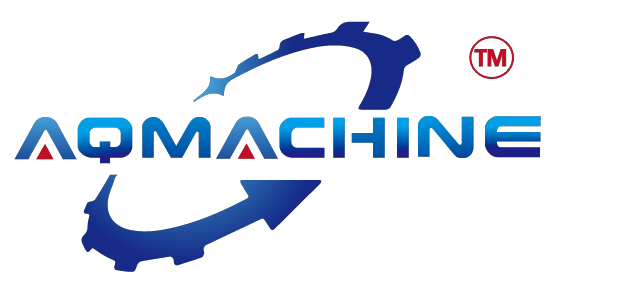Unleashing Creativity: Non Woven Apron Machine with Customizable Servo Printing
I. Introduction: A Revolution in Apron Printing Technology
A. The Evolution of Non Woven Apron Machines
In the dynamic landscape of manufacturing, Non Woven Apron Machines have evolved into precision instruments, and the latest innovation—customizable servo printing—ushers in a new era of creative possibilities.
B. Unveiling the Power of Customization with Servo Printing
Non Woven Apron Machines equipped with servo printing systems empower manufacturers to create aprons with intricate and personalized designs, catering to diverse customer preferences and industry requirements.
II. Understanding the Apron Manufacturing Process: Precision at Every Step
A. Jumbo Roll Feeding: The Starting Point
The process begins with jumbo roll feeding, laying the foundation for efficient apron production.
B. Edge Position Control for Flawless Execution
Edge position control ensures the accuracy of each apron, contributing to a flawless end product.
C. Tension Controlling: Ensuring Stability
Maintaining optimal tension throughout the manufacturing process is crucial for stability and high-quality apron production.
D. Printing: Bringing Designs to Life
Servo printing systems enable the transformation of plain fabric into vibrant, customized aprons, meeting the demands of various industries.
E. Drying: Swift and Efficient
A dedicated drying system ensures that printed designs dry quickly, streamlining the production timeline.
F. Horizontal Material Transition: Enhancing Efficiency
Efficiently transitioning materials horizontally contributes to the overall effectiveness of the manufacturing process.
G. Folding Stages: From 1/2 to 1/3 Folding
The machine seamlessly executes folding stages, achieving precise 1/2 and 1/3 folds to create neatly folded aprons.
H. Neck Hole and Corner Cutting: Crafting the Perfect Shape
Specialized cutting and molding features shape the apron, including precise neck hole and corner cutting.
I. Adhesive Tape Addition: Meeting Unique Requirements
Adhesive tape application provides customization options, allowing manufacturers to meet specific product requirements.
J. Waste Management: Vacuum Pump for Clean Production
A vacuum pump efficiently manages waste material, contributing to a clean and organized workspace.
K. Servo-Driven Fabric Length Folding: Tailoring Sizes to Perfection
The machine’s servo-driven system precisely controls fabric length folding, ensuring the final product meets customer specifications.
L. Stacking System with Number Counting: Streamlining Output
Efficient stacking systems with number counting functionality streamline the production output and inventory management.
M. Conveyor Belt Output: Seamless Production Flow
The finished folded products smoothly move along the conveyor belt, concluding the production cycle with a seamless flow.
III. Machine Specification: Engineering Excellence at a Glance
A. Unwinding Width: 500mm of Effectiveness
The machine boasts an effective unwinding width of 500mm, providing ample space for efficient apron production.
B. Automatic Correction Device (EPC): Ensuring Precision
An automatic correction device (EPC) on the unwinding part ensures precision in folding, contributing to the overall quality of the end product.
C. Servo Printing System: Quality Control in Every Print
The servo printing system guarantees high-quality prints, offering manufacturers control over the printing effect, particularly in one-color printing applications.
D. Drying System: Speeding Up the Process
A dedicated drying system accelerates the drying of printed designs, enhancing the speed and efficiency of the manufacturing process.
E. Triangle Board Folding Device: Easy Manual Adjustments
The inclusion of a triangle board folding device allows for easy manual adjustments, providing flexibility in the folding process.
F. Cutting and Molding Features: Precision in Detail
Specialized features for neck hole cutting, corner cutting, and cutting off mold on the roller contribute to the precision of each apron.
G. Adhesive Tape Application: Meeting Product Requirements
The machine accommodates adhesive tape application, offering customization options to meet specific product requirements.
H. Waste Management with Vacuum Pump: A Cleaner Workspace
Efficient waste management through a vacuum pump ensures a clean and organized workspace, promoting a more sustainable production process.
I. Servo-Driven Fabric Length Folding: Tailoring Sizes to Perfection
The servo-driven fabric length folding system allows manufacturers to tailor the sizes of folded fabrics precisely, meeting customer demands with ±5mm tolerance.
J. Stacking System with Number Counting: Efficient Output
A stacking system equipped with number counting functionality streamlines the production output, providing manufacturers with an efficient means of tracking quantities.
K. Conveyor Belt Output: A Seamless Production Flow
The conveyor belt output ensures a seamless production flow, delivering finished folded products with precision and efficiency.
L. Precision Tolerance: ±5mm for Consistency
The machine’s precision tolerance of ±5mm ensures consistent results, meeting the highest standards in apron manufacturing.
IV. Non Woven Apron Machine in Action: Applications and Benefits
A. Exploring Versatile Applications of Customizable Servo Printing
Beyond the apron manufacturing process, the customizable servo printing feature opens doors to a myriad of applications, from promotional aprons with intricate branding to personalized designs for the hospitality and healthcare sectors.
B. The Economic Advantages of Non Woven Apron Machines
Investing in Non Woven Apron Machines not only ensures high-quality, customized products but also offers economic advantages through enhanced production efficiency and reduced material wastage.
V. Choosing the Right Partner: Navigating Non Woven Apron Machine Suppliers
A. Evaluating Chinese Manufacturers: Quality, Cost, and Services
When considering suppliers in China, manufacturers should prioritize factors such as product quality, cost-effectiveness, and the range of services offered.
B. Customization Services: Tailoring Machines to Unique Requirements
A reputable supplier should provide customization services to tailor Non Woven Apron Machines according to unique manufacturing requirements, ensuring a seamless integration into existing production processes.
VI. The Future of Non Woven Apron Machines: Innovation and Beyond
A. Technological Advancements Shaping the Future
Ongoing technological advancements are expected to further enhance Non Woven Apron Machines, introducing features that elevate efficiency, reduce environmental impact, and offer even greater customization capabilities.
B. Anticipating Industry Trends in Apron Manufacturing
Keeping an eye on emerging trends in apron manufacturing, such as sustainable materials and smart technologies, will be crucial for businesses looking to stay ahead of the curve.
VII. Frequently Asked Questions: A Buyer’s Guide to Non Woven Apron Machines
A. Key Inquiries for International Buyers
- How does the machine ensure precise folding and cutting?
- The machine employs advanced features such as servo-driven systems and automatic correction devices to ensure precision throughout the manufacturing process.
- What customization options are available with the servo printing system?
- The servo printing system allows for intricate one-color prints, providing manufacturers with the flexibility to create unique and personalized designs.
- How does the machine manage waste during production?
- Waste management is handled efficiently with a vacuum pump, ensuring a clean and organized workspace.
- Can the machine be adjusted for different apron sizes?
- Yes, the servo-driven fabric length folding system allows for easy adjustments, enabling manufacturers to tailor apron sizes according to customer specifications.
- How does the stacking system contribute to efficient production?
- The stacking system, equipped with number counting functionality, streamlines output and facilitates easy inventory management.
- What is the precision tolerance of the machine?
- The machine ensures precision with a tolerance of ±5mm, guaranteeing consistency in the final product.
B. Understanding the Pricing Structure and Services
- What factors influence the cost of a Non Woven Apron Machine?
- The cost may vary based on factors such as machine specifications, customization requirements, and additional features.
- Do suppliers offer installation and training services?
- Reputable suppliers often provide comprehensive services, including installation, training, and ongoing support to ensure optimal machine performance.
- Is customization available for specific industry needs?
- Yes, customization services are typically offered to meet the unique requirements of different industries, from hospitality to healthcare.
- Are there additional costs associated with machine maintenance?
- Maintenance costs are generally low and stable, thanks to the use of high-quality components and advanced design concepts.
- Can the machine be adapted for future technological updates?
- Suppliers may offer machines with the flexibility to incorporate future technological updates, ensuring longevity and relevance in a rapidly evolving industry.
VIII. Conclusion: Redefining Apron Production with Non Woven Technology
A. The Impact of Customizable Servo Printing
Non Woven Apron Machines equipped with customizable servo printing are transforming apron production, allowing manufacturers to unleash creativity and meet the demands of a diverse market.
B. Embracing the Future of Apron Manufacturing with Non Woven Machines
As technology continues to advance, Non Woven Apron Machines will play a pivotal role in shaping the future of apron manufacturing, offering innovative solutions and pushing the boundaries of customization and efficiency.



